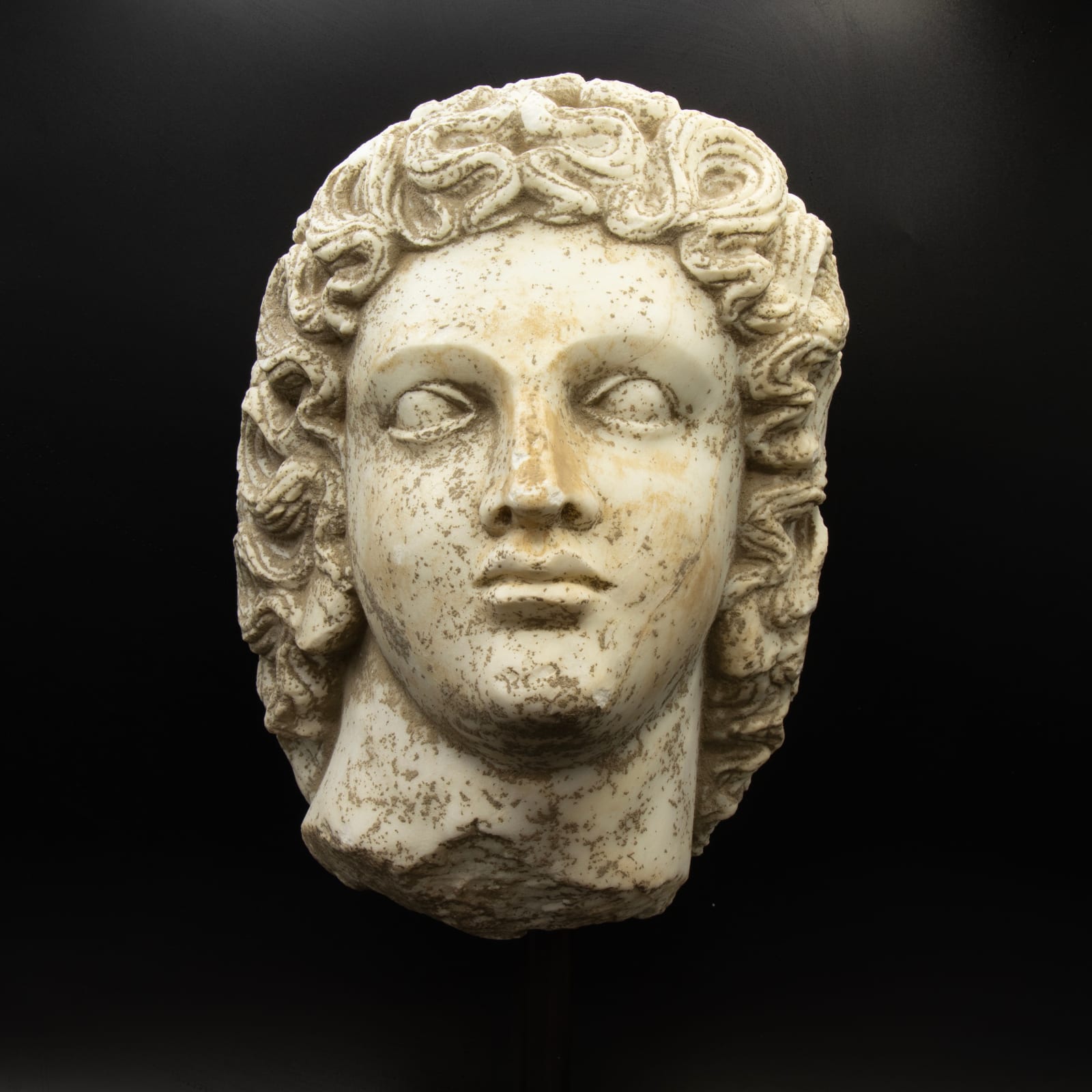Classical Revival Bust of Alexander the Great, in the Guise of Helios, 19th Century CE
Marble
29.7 x 21.2 x 20.7 cm
11 3/4 x 8 3/8 x 8 1/8 in
11 3/4 x 8 3/8 x 8 1/8 in
LI.1006
This is an exceptional Classical Revival Marble Head of Alexander the Great, based on the Alexander as Helios bust in the Capitoline Museums in Rome. The Macedonian ruler is here...
This is an exceptional Classical Revival Marble Head of Alexander the Great, based on the Alexander as Helios bust in the Capitoline Museums in Rome. The Macedonian ruler is here depicted in-the-round, with elongated muscular neck and head very slightly tilted left. His forehead is smooth and the deep-set eyes are heavily lidded; triangular nose and small mouth with flashy lips. Full head of thick curls styled in characteristic anastole, whereby hair is brushed up from the forehead and arranged wreath-like around the face.
This is a stunning artwork in Neo Classical style, witnessing to the great fascination exercised by Alexander in the Modern era.
Alexander III of Macedon, universally known as Alexander the Great, single-handedly changed the nature of the ancient world in little more than a decade. Born in Pella, the ancient capital of Macedonia in July 356 BC. to King Philip II of Macedon and his wife Olympias. Alexander was educated by the philosopher Aristotle. Philip was assassinated in 336 BC and Alexander inherited a powerful yet volatile kingdom at the age of 20. He quickly dealt with his enemies at home and reasserted Macedonian power within the remaining territory of what is nowadays Greece. He then set out with is army to conquer the immense Persian Empire. Against overwhelming odds, he led his army to victories across the Persian territories of Asia Minor, Syria and Egypt without suffering a single defeat. His greatest victory was at the Battle of Gaugamela, close to the modern city of Dohuk, in what is now northern Iraq, in 331 BC. The young king of Macedonia, leader of the Greeks, overlord of Asia Minor and pharaoh of Egypt became 'great king' of Persia at the age of 25. Over the next eight years, in his capacity as king, commander, politician, scholar and explorer, Alexander led his army a further 11,000 miles, founding over 70 cities and creating an empire that stretched across three continents and covered around two million square miles. The entire area from Greece in the west, north to the Danube, south into Egypt and as far to the east as the Indian Punjab, was linked together in a vast international network of trade and commerce. This was united by a common Greek language and culture, while the king himself adopted foreign customs in order to rule his millions of ethnically diverse subjects. Alexander was acknowledged as a military genius who always led by example, although his belief in his own indestructibility meant he was often reckless with his own life and that of his soldiers. The fact that his army only refused to follow him once in 13 years of a reign during which there was constant fighting, indicates the loyalty he inspired. He died of a fever in Babylon in June 323 BC.
This is a stunning artwork in Neo Classical style, witnessing to the great fascination exercised by Alexander in the Modern era.
Alexander III of Macedon, universally known as Alexander the Great, single-handedly changed the nature of the ancient world in little more than a decade. Born in Pella, the ancient capital of Macedonia in July 356 BC. to King Philip II of Macedon and his wife Olympias. Alexander was educated by the philosopher Aristotle. Philip was assassinated in 336 BC and Alexander inherited a powerful yet volatile kingdom at the age of 20. He quickly dealt with his enemies at home and reasserted Macedonian power within the remaining territory of what is nowadays Greece. He then set out with is army to conquer the immense Persian Empire. Against overwhelming odds, he led his army to victories across the Persian territories of Asia Minor, Syria and Egypt without suffering a single defeat. His greatest victory was at the Battle of Gaugamela, close to the modern city of Dohuk, in what is now northern Iraq, in 331 BC. The young king of Macedonia, leader of the Greeks, overlord of Asia Minor and pharaoh of Egypt became 'great king' of Persia at the age of 25. Over the next eight years, in his capacity as king, commander, politician, scholar and explorer, Alexander led his army a further 11,000 miles, founding over 70 cities and creating an empire that stretched across three continents and covered around two million square miles. The entire area from Greece in the west, north to the Danube, south into Egypt and as far to the east as the Indian Punjab, was linked together in a vast international network of trade and commerce. This was united by a common Greek language and culture, while the king himself adopted foreign customs in order to rule his millions of ethnically diverse subjects. Alexander was acknowledged as a military genius who always led by example, although his belief in his own indestructibility meant he was often reckless with his own life and that of his soldiers. The fact that his army only refused to follow him once in 13 years of a reign during which there was constant fighting, indicates the loyalty he inspired. He died of a fever in Babylon in June 323 BC.



